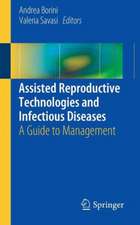Human Gametes and Preimplantation Embryos: Assessment and Diagnosis
Editat de David K. Gardner, Denny Sakkas, Emre Seli, Dagan Wellsen Limba Engleză Hardback – 27 mai 2013
Human Gametes and Preimplantation Embryos: Assessment and Diagnosis provides a broad yet concise overview of established and developing methodologies for assessment of gamete and embryo viability in assisted reproduction. This book elucidates the best practices for precisely selecting viable specimens based on morphology and cleavage rate and covers the spectrum of emerging adjunctive technologies for predicting reproductive potential. The authors present their extensive knowledge of “omics” approaches (genomics, transcriptomics, proteomics, and metabolomics), with unbiased delineation of the associated advantages and potential pitfalls. This valuable clinical resource is well suited to infertility specialists, Ob/Gyn physicians, IVF laboratory technicians, and researchers in the fields of embryology and reproductive medicine.
| Toate formatele și edițiile | Preț | Express |
|---|---|---|
| Paperback (1) | 784.64 lei 6-8 săpt. | |
| Springer – 23 aug 2016 | 784.64 lei 6-8 săpt. | |
| Hardback (1) | 1116.73 lei 6-8 săpt. | |
| Springer – 27 mai 2013 | 1116.73 lei 6-8 săpt. |
Preț: 1116.73 lei
Preț vechi: 1175.51 lei
-5% Recomandat Nou
Puncte Express: 1675
Preț estimativ în valută:
213.71€ • 222.30$ • 176.43£
213.71€ • 222.30$ • 176.43£
Carte tipărită la comandă
Livrare economică 14-28 aprilie
Preluare comenzi: 021 569.72.76
Specificații
ISBN-13: 9781461466505
ISBN-10: 1461466504
Pagini: 306
Ilustrații: XV, 306 p. 64 illus., 48 illus. in color.
Dimensiuni: 178 x 254 x 20 mm
Greutate: 0.98 kg
Ediția:2013
Editura: Springer
Colecția Springer
Locul publicării:New York, NY, United States
ISBN-10: 1461466504
Pagini: 306
Ilustrații: XV, 306 p. 64 illus., 48 illus. in color.
Dimensiuni: 178 x 254 x 20 mm
Greutate: 0.98 kg
Ediția:2013
Editura: Springer
Colecția Springer
Locul publicării:New York, NY, United States
Public țintă
Professional/practitionerCuprins
Current Practices and Regulations for Embryo Transfer Worldwide: Implications on IVF Outcome.- Analysis of the Zona Pellucida as an Indicator of Oocyte Developmental Potential.- Morphological Assessment of Oocytes, Pronuclear and Cleavage Stage Embryos.- Morphological Assessment of Blastocyst Stage Embryos: Types of Grading Systems and Their Reported Outcomes.- Real Time Imaging Strategies to Improve Morphological Assessment.- Limitations and Benefits of Morphologic Embryo Assessment Strategies: How Far Can Morphological Assessment Go in the Identification of Viable Embryos?.- Sperm Morphologic Characteristics and Their Impact on Embryo Quality and Pregnancy Outcome.- Objective Biomarkers of Sperm Development and Fertility: Assessment of Sperm-Zona Pellucida Binding Ability and Hyaluronic Acid Mediated Selection of Sperm for ICSI Fertilization.- Selecting the Best Sperm and Its Implications in Clinical Practice.- The Origins of Aneuploidy in Human Embryos.- Preimplantation Genetic Screening and Diagnosis Using Fluorescent In Situ Hybridization (FISH).- Single Nucleotide Polymorphisms and Next Generation Sequencing.- Use of Comparative Genomic Hybridization (CGH) and Microarray-CGH for Preimplantation Genetic Screening.- Quantitative SNP Array and Real-Time PCR Based Human Preimplantation Embryo Aneuploidy Screening.- Regulation of Gene Expression in the Oocyte and Early Embryo: Implications for Transcriptomic and Proteomic Embryo Assessment.- Transcriptomics Technology: Promise and Potential Pitfalls.- Transcriptomic Analysis of Cumulus and Granulosa Cells as a Marker of Embryo Viability.- Mass Spectrometry, Proteomics and the Study of Sperm Cell Biology.- Proteomic Analysis of Embryo Viability.- Metabolism of the Viable Human Embryo.- Analysis of Respiration as an Indicator of Oocyte and Embryo Developmental Potential.- Mitochondrial Activity as a Biomarker of Gamete and Embryo Health.- Carbohydrate Analysis and Embryo Viability.- Identification of ViableEmbryos by Non-invasive Measurement of Amino Acids in Culture Media.- Metabolomic Profiling of Embryos Using Spectroscopy.- Microfluidic Devices for the Analysis of Gamete and Embryo Physiology.
Textul de pe ultima copertă
In recent years, the advancing science and increasing availability of assisted reproduction have given new hope to infertile couples. However, the use of IVF and ART has also led to marked increases in the number of multiple-infant live births. This poses a public health concern, as these neonates have a higher rate of pre-term delivery, compromising their survival chances and increasing their risk of lifelong disability. By optimizing the selection of gametes and embryos with high probabilities of implantation, it is possible to reduce the number of embryos transferred and, by extension, the number of high-risk multiple gestations, while maintaining or increasing pregnancy rates.
Human Gametes and Preimplantation Embryos: Assessment and Diagnosis provides a broad yet concise overview of established and developing methodologies for assessment of gamete and embryo viability in assisted reproduction. This book elucidates the best practices for precisely selecting viable specimens based on morphology and cleavage rate and covers the spectrum of emerging adjunctive technologies for predicting reproductive potential. The authors present their extensive knowledge of “omics” approaches (genomics, transcriptomics, proteomics, and metabolomics), with unbiased delineation of the associated advantages and potential pitfalls. This valuable clinical resource is well suited to infertility specialists, Ob/Gyn physicians, IVF laboratory technicians, and researchers in the fields of embryology and reproductive medicine.
Human Gametes and Preimplantation Embryos: Assessment and Diagnosis provides a broad yet concise overview of established and developing methodologies for assessment of gamete and embryo viability in assisted reproduction. This book elucidates the best practices for precisely selecting viable specimens based on morphology and cleavage rate and covers the spectrum of emerging adjunctive technologies for predicting reproductive potential. The authors present their extensive knowledge of “omics” approaches (genomics, transcriptomics, proteomics, and metabolomics), with unbiased delineation of the associated advantages and potential pitfalls. This valuable clinical resource is well suited to infertility specialists, Ob/Gyn physicians, IVF laboratory technicians, and researchers in the fields of embryology and reproductive medicine.
Caracteristici
Provides an overview of existing morphologic assessment strategies as well as developing novel technologies Presents emerging “omics” techniques for recognizing potential gamete and embryo viability for implantation Creates a unique resource for both practicing clinicians and researchers in the field of assisted reproduction Gives expert knowledge of clinical practices and techniques, including their potential benefits and pitfalls Includes supplementary material: sn.pub/extras






















